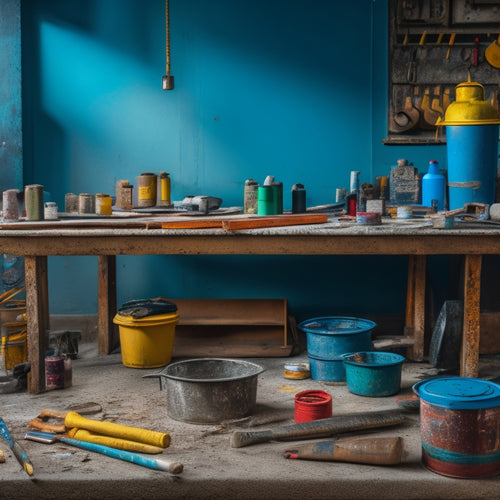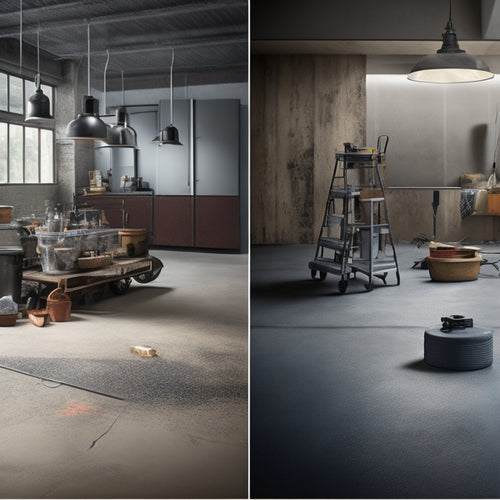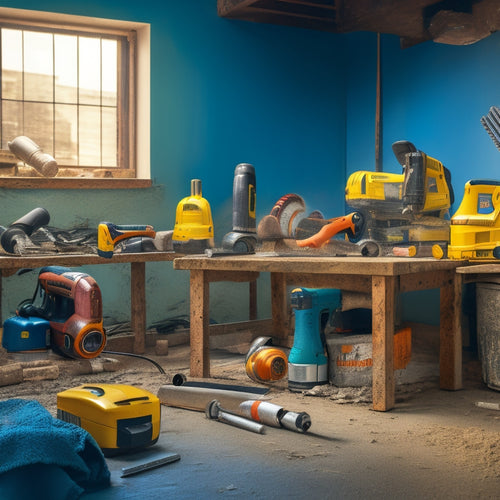
What Are the Best Hand Tools for Concrete
Share
When working with concrete, having the right hand tools is essential for achieving a smooth, professional-grade finish. You'll need a variety of trowels, including pointed, flat, and notched, as well as finishing tools like edgers, floats, and scrapers. Edgers with durable, rust-resistant blades and comfortable grips are vital for creating clean, sharp edges. Handheld grinders and chisels are necessary for removing imperfections and breaking up concrete. Tamping tools help compact soil and gravel for a solid foundation. By selecting the best hand tools for your concrete project, you'll be well on your way to achieving a high-quality finish - and learning more about the specifics of each tool will help you take your skills to the next level.
Key Takeaways
• A variety of trowels, including pointed, flat, and notched, are essential for concrete work, each serving specific purposes.
• Edgers, such as edger, trowel, float, and finishing trowel, are necessary for achieving perfect edges and smooth finishes.
• Blade material, such as high-carbon steel and diamond-coated, and handle material, like fiberglass and aluminum, impact the quality of finish and tool durability.
• Scrapers and grinders, including concrete scrapers and handheld grinders, are vital for removing old concrete, imperfections, and smoothing rough patches.
• Chisels and tamping tools, such as point chisels and plate compactors, are necessary for heavy-duty applications, demolition, and compacting soil and gravel for foundation stability.
Essential Trowels for Concrete Work
You'll need a range of trowels in your concrete toolkit, as they're essential for applying, smoothing, and finishing concrete surfaces.
There are several trowel types to familiarize yourself with, including pointed trowels for applying and spreading concrete, flat trowels for smoothing and finishing, and notched trowels for creating textures and patterns. Each type serves a specific purpose, and having the right one for the job will make a significant difference in the quality of your work.
To get the most out of your trowels, regular maintenance is vital. Clean your trowels thoroughly after each use, and store them in a dry place to prevent rust or corrosion.
Regularly inspect your trowels for signs of wear and tear, and replace them when necessary. A well-maintained trowel will provide a smooth, even finish, while a worn-out one can lead to uneven surfaces and poor results.
Best Edgers for Smooth Finishes
When you're working towards a smooth, professional-looking concrete finish, you need an edger that gives you control and precision.
You'll want to contemplate the type of edge control options available, as well as the material used for the blade, to guarantee you're getting the results you need.
Edge Control Options
Achieving a smooth finish on concrete surfaces relies heavily on effective edge control, which is where the right edger comes into play. You need an edger that can handle the demands of edge control techniques, ensuring a seamless shift from the main surface to the edge. When it comes to edge finishing methods, you'll want an edger that can deliver a precise, smooth finish.
For edge control, you'll want to take into account an edger with adjustable handles, allowing you to customize the fit to your needs. This will give you better control over the edger, enabling you to work efficiently and accurately.
Look for an edger with a durable, rust-resistant blade that can withstand the rigors of concrete work. A good edger should also have a comfortable grip, reducing fatigue and making it easier to work for extended periods.
Blade Material Matters
With the right edger in hand, it's time to focus on the blade material, as it plays a significant role in determining the quality of the finish, particularly when working towards a smooth, even surface. You'll want a blade that can withstand the rigors of concrete cutting, maintaining its edge and performance over time. Look for blades made from high-carbon steel or diamond-coated blades, which offer superior blade durability and cutting efficiency.
High-carbon steel blades are ideal for general-purpose edging, providing a good balance between durability and affordability. They're suitable for most concrete applications, but may require more frequent sharpening.
Diamond-coated blades, on the other hand, are perfect for heavy-duty edging and offer exceptional cutting efficiency. They're more expensive, but their diamond-coated edges stay sharp longer, reducing the need for frequent sharpening.
When choosing a blade material, consider the type of concrete you're working with, the frequency of use, and your budget. By selecting the right blade material, you'll achieve a smoother finish, reduce labor time, and extend the life of your edger.
Finishing Touch Essentials
You'll need an edger that's specifically designed for smooth finishes, one that can precision-cut and refine the concrete surface to perfection. For a flawless finish, you can't rely on just any edger.
Look for one with adjustable handles and a comfortable grip to reduce fatigue. A high-carbon steel or diamond-coated blade is essential for smooth, precise cuts.
When choosing an edger, consider the type of concrete you're working with and the desired finish. For example, a walk-behind edger is ideal for large, flat areas, while a handheld edger is better suited for tighter spaces and curved edges.
To achieve a high-gloss finish, pair your edger with advanced smoothing techniques and finishing products. These may include specialized trowels, floats, and sealers designed to enhance the appearance and durability of your concrete.
Top Rated Floats for Concrete
When it comes to choosing the right float for your concrete project, you'll want to take into account a few key factors.
You'll need to decide between bull float options, which are ideal for larger areas, and edger types, which are better suited for smaller spaces and details.
Additionally, don't overlook the importance of handle material, as it can affect the overall comfort and durability of your float.
Bull Float Options
Five top-rated bull floats for concrete stand out from the rest, offering superior performance and durability for your finishing tasks. When choosing the right bull float, you'll want to take into account the materials, sizes, and features that suit your specific needs.
Here are four top-rated bull floats to take into account:
-
Marshalltown 14814: A premium aluminum bull float with a 4-foot length and 12-inch width, ideal for large areas and heavy-duty use.
-
Bon Tool 14-504: A heavy-duty steel bull float with a 4-foot length and 10-inch width, perfect for high-traffic areas and rough concrete.
-
Kraft Tool CF144: A lightweight aluminum bull float with a 4-foot length and 12-inch width, great for smaller areas and precise control.
- Magnum 144: A high-quality magnesium bull float with a 4-foot length and 12-inch width, offering superior durability and rust resistance.
When selecting a bull float, take into account the material (aluminum, steel, or magnesium), size (length and width), and features (handle type, blade angle, and weight) that best fit your project requirements.
Edger Types Compared
Your edger options for concrete finishing tasks include walk-behind, ride-on, and handheld edgers, each designed to tackle specific jobs and offer unique benefits.
Walk-behind edgers are ideal for larger areas, providing more power and efficiency. Ride-on edgers are perfect for massive projects, allowing you to cover more ground quickly. Handheld edgers, on the other hand, are best suited for smaller, more intricate areas, offering greater control and precision.
When choosing an edger, consider the different edger designs and their features. Look for edger handle features that provide comfort and support, such as ergonomic grips, adjustable handles, and shock-absorbing technology.
These features will help reduce fatigue and improve your overall performance. Additionally, consider the edger's weight, balance, and maneuverability, as these factors will impact your ability to work efficiently.
Handle Material Matters
You'll find that the right float handle material can make a significant difference in your concrete finishing tasks, especially when paired with the ideal edger type for your project. A high-quality handle can improve your overall performance and reduce fatigue.
When selecting a float handle, consider the following key factors:
-
Durable materials: Look for handles made from materials like fiberglass, aluminum, or wood, which offer excellent handle durability and can withstand the rigors of concrete finishing.
-
Ergonomic design: Opt for handles with ergonomic grips that fit comfortably in your hand, reducing strain and discomfort during extended use.
-
Balance and weight distribution: A well-balanced handle can help you maintain control and precision while working with the float.
- Grip texture and material: A textured grip or one made from a non-slip material can help prevent accidents and improve your overall control.
Concrete Scrapers for Easy Removal
When tackling concrete removal projects, a sturdy concrete scraper is an essential tool that saves you time and effort by efficiently scraping away old, deteriorated concrete. With the right scraper, you can remove old concrete quickly and safely, making way for new installations or repairs.
To get the most out of your scraper, it's vital to maintain it properly. Follow scraper maintenance tips like cleaning the blade after each use, storing it in a dry place, and sharpening it regularly to prevent rust and damage.
When it comes to concrete removal techniques, a scraper is a versatile tool that can be used for various applications. For instance, you can use it to scrape away old adhesive or remove excess concrete from surfaces.
By combining your scraper with other hand tools, like chisels and hammers, you can tackle even the most challenging concrete removal projects. Remember to always work in small sections, taking care not to apply too much pressure, which can damage the surrounding concrete.
With practice and patience, you'll master concrete removal techniques and be able to tackle any project that comes your way.
Finishing Tools for Perfect Edges
With the old concrete removed, it's time to focus on achieving perfect edges with the right finishing tools, which can make all the difference in the final appearance of your concrete project. You want your edges to be smooth, even, and visually appealing, and that requires the right techniques and tools.
To master finishing techniques and achieve exceptional edge aesthetics, you'll need the following essential tools:
-
Edger: A handheld edger is perfect for creating clean, sharp edges and removing excess concrete.
-
Trowel: A high-quality trowel helps you achieve a smooth, even finish and is ideal for applying finishing compounds.
-
Float: A magnesium or resin float is used to smooth and flatten the concrete surface, preparing it for final finishing.
- Finishing trowel: A finishing trowel is used for the final touches, ensuring a smooth, blemish-free finish.
With these tools in your arsenal, you'll be well on your way to achieving professional-grade finishing techniques and stunning edge aesthetics that will elevate your concrete project to the next level.
Handheld Grinders for Concrete
Handheld grinders are an important addition to your concrete toolkit, allowing you to effectively remove imperfections, smooth out rough patches, and prepare surfaces for finishing.
When choosing a handheld grinder, you'll come across different types, including angle grinders, die grinders, and rotary grinders. Each type is suited for specific tasks, so it's vital to select the right one for your project. Angle grinders, for example, are ideal for heavy-duty grinding and cutting, while die grinders are better suited for precision work and detail grinding.
Before you start grinding, remember to follow important grinder safety tips. Always wear protective gear, including gloves, safety glasses, and a dust mask. Make certain the grinder is properly secured and balanced in your hand to avoid accidents.
Keep the work area clean and clear of debris to prevent slipping and tripping hazards. Additionally, regularly inspect your grinder for wear and tear, and replace worn or damaged parts promptly.
Concrete Chisels for Heavy Duty
You'll need concrete chisels for heavy-duty projects that require breaking up thick concrete, removing old flooring, or demolishing walls. These chisels are designed to withstand the rigors of tough concrete jobs and are vital for any serious concrete worker.
When selecting concrete chisels, consider the following key factors:
-
Chisel types: There are three main types of concrete chisels: point chisels, flat chisels, and claw chisels. Point chisels are ideal for breaking up concrete, flat chisels are best for scraping and removing old flooring, and claw chisels are perfect for demolishing walls.
-
Hammer compatibility: Verify the chisel is compatible with your hammer. Look for chisels with a comfortable handle and a secure fitting to prevent the chisel from slipping out of the hammer.
-
Durability: Heavy-duty concrete chisels should be built to last, with high-carbon steel or other durable materials that can withstand repeated use.
- Ergonomics: A comfortable, ergonomic design is essential for reducing fatigue and improving productivity.
Tamping Tools for Solid Foundations
After demolishing walls and breaking up concrete, it's time to prepare the ground for new foundations, and that's where tamping tools come in to secure a solid base.
You'll need to compact the soil and gravel to ascertain foundation stability, and that's where tamping techniques come into play. A tamping tool helps to remove air pockets, excess water, and loose material, allowing you to create a stable and even surface.
When choosing a tamping tool, consider the type of foundation you're building and the soil conditions. A plate compactor or hand tamper is ideal for small to medium-sized projects, while a jumping jack compactor or power tamper is better suited for larger projects.
Regardless of the tool you choose, make sure to follow proper tamping techniques to avoid over-compacting the soil, which can lead to settlement issues.
Frequently Asked Questions
Can I Use Hand Tools for Large-Scale Concrete Projects?
When tackling large-scale concrete projects, you'll need to take into account efficiency carefully.
While hand tools can be effective, they mightn't be the best choice for massive projects. You'll likely need to sacrifice speed and efficiency, which can impact your project's timeline and budget.
For large-scale applications, it's often more practical to opt for power tools or specialized equipment designed for heavy-duty concrete work, ensuring you can complete tasks efficiently and effectively.
How Do I Prevent Rust on My Concrete Hand Tools?
To prevent rust on your concrete hand tools, you'll want to focus on proper tool storage and rust prevention.
After each use, clean your tools thoroughly and dry them with a soft cloth.
Apply a rust-inhibiting coating or lubricant to metal surfaces.
Store your tools in a dry place, away from direct sunlight, and consider using a rust-resistant tool chest or bag.
Are Concrete Hand Tools Suitable for DIY Projects?
You're the master builder of your DIY kingdom, and you're wondering if concrete hand tools are worthy of your projects. The answer is a resounding yes!
With the right DIY tool selection, you'll find that concrete hand tools are incredibly versatile. They can tackle everything from mixing and finishing to demolition and repair.
Their durability and reliability make them an essential addition to your toolkit, empowering you to take on a wide range of projects with confidence.
Can I Use Hand Tools on Freshly Poured Concrete?
When working with fresh concrete, you'll want to exercise caution when applying hand tools.
Avoid using them immediately after pouring, as this can damage the surface or compromise the concrete's integrity. Instead, wait until the concrete has set enough to allow for gentle, controlled hand tool applications.
This will guarantee you achieve the desired finish without risking defects. By mastering fresh concrete techniques, you'll be able to expertly use hand tools to achieve professional-looking results.
How Often Should I Clean and Maintain My Hand Tools?
As you wield your trusty tools, wispy wires of weariness whisper warnings of waning performance.
Don't let grime and grit grind your workflow to a halt! Establish a cleaning schedule to guarantee tool longevity.
You should clean and maintain your hand tools after each use, storing them in a dry place to prevent rust.
Regularly inspect and sharpen blades, and lubricate moving parts to keep them in top condition.
Conclusion
Mastering concrete work requires the right arsenal of hand tools.
With these top picks, you'll be well-equipped to tackle any project. From trowels that tame tough textures to edgers that create silky smooth finishes, and from floats that fine-tune to scrapers that swiftly remove, you'll be crafting concrete masterpieces in no time.
So, grab these go-to tools and get ready to groove, grind, and glamour your way to concrete perfection.
Related Posts
-

Essential Tools for Painting Concrete Walls
When painting concrete walls, you'll need a range of specialized tools to achieve a professional-looking finish. Star...
-

Top Tools for Revamping Old Concrete Floors
You'll need a range of tools to revamp your old concrete floor, starting with epoxy, acrylic, or polyurethane paint, ...
-

Essential Power Tools for Concrete Block Construction
When building with concrete blocks, you'll need a range of power tools to cut, drill, mix, and finish the blocks to g...


